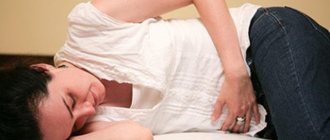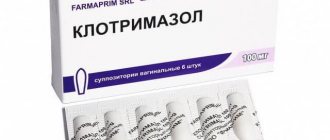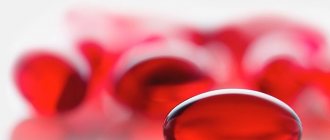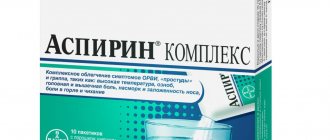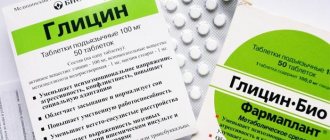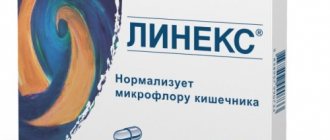Views - 25,312
Women often face such a delicate problem as hemorrhoids immediately after giving birth to a child. This disease causes a lot of unpleasant sensations and can seriously ruin the life of any new mother. It is impossible to delay the treatment of hemorrhoids, but the choice of means to get rid of it during lactation should be approached very carefully. Is it possible to use such a well-known drug as “Relief” while breastfeeding?
- The principle of action of the drug
- Is Relief safe while breastfeeding?
- Methods of taking the drug
- Is it possible to replace the drug with something?
Video - what are hemorrhoids and how to treat them?
In what cases is Relief necessary during breastfeeding?
The indication for use of the drug Relief is hemorrhoids. Ointment and suppositories, as part of a comprehensive treatment for hemorrhoids, relieve painful symptoms and promote the healing of cracks and erosions in the anus. Relief is also recommended for inflammatory processes in the rectal mucosa. Other indications for use of Relief:
- anal itching;
- eczema;
- perianal dermatitis (inflammation in the anus and surrounding skin).
Hemorrhoids in a nursing woman
After childbirth, many women have to deal with hemorrhoids. The prevalence of this disease among women who have given birth is due to the fact that during natural labor (in particular, during the period of pushing), overstrain of the muscles of the perineum, sphincter and hemorrhoidal veins occurs. At risk for hemorrhoids are women who have gained excessive weight during pregnancy and exercised little, as well as expectant mothers who have experienced constipation.
The risk of hemorrhoids in a woman can be reduced by eating foods high in fiber and not gaining extra pounds, as well as by leading an active lifestyle.
Video: features of postpartum hemorrhoids
Physiologically, hemorrhoids are caused by heredity, a tendency to thinning and stretching of the veins of the rectum. Possible intake of hormonal drugs also provokes the occurrence of hemorrhoidal condition.
One of the causes of hemorrhoids is a hereditary predisposition to this disease. Several years ago, having become a mother for the second time, the author of these lines felt the brunt of “bad” heredity. During pregnancy, I did not gain excess weight beyond the permissible norm, I did not sit on the couch for days - these reasons for the appearance of hemorrhoids are excluded. Doctors say that lifting weights causes hemorrhoids to enlarge. In response to this, for myself, I will say that I often have to do hard physical work, but during pregnancy this was excluded for obvious reasons. So, the doctor diagnosed hemorrhoids with accompanying pain when walking; taking a sitting position was generally something out of the realm of fantasy. At the same time, you also need to take care of the baby, who constantly needs his mother’s care.
How to recognize hemorrhoids
Like any other disease, hemorrhoids are easier to treat when they occur rather than at a later stage of the disease. This is especially true for nursing mothers, on whose health the well-being of their babies depends.
What symptoms should alert a woman? First of all, these are painful sensations (including itching, burning, a feeling of heaviness) in the rectum, blood in the stool.
Hemorrhoids are accompanied by dilation of the veins in the rectum with possible bleeding
A visible sign of the disease is swelling in the form of “bumps” in the external or internal area of the anus. When such enlarged hemorrhoids “fall out,” they speak of external hemorrhoids; when they are located inside the anus, they speak of internal hemorrhoids. The veins of the rectum swell, become inflamed, and the woman experiences pain (sometimes unbearable) in the perineum.
How dangerous is the disease for a nursing mother?
Any pathological condition that occurs in a nursing mother can be severe, with the risk of complications. This is due to the fact that after childbirth the female body is weakened and vulnerable. Hemorrhoids after childbirth not only delay the recovery of the female body, but also significantly complicate it.
Hemorrhoids with possible accompanying bleeding in the postpartum period can provoke infection and the development of inflammatory processes
The advanced course of the disease without proper treatment and medical supervision is dangerous due to the development of complications such as:
- anemia (decreased hemoglobin concentration in the blood);
- paraproctitis (rectal disease);
- thrombophlebitis (a venous disease in which a blood clot forms in the lumen of a vein against the background of inflammation of the venous wall);
- strangulation of the external hemorrhoid (or its necrosis);
- development of oncological tumors.
Therefore, it is important to consult a proctologist in a timely manner so that he can prescribe effective treatment that is compatible with the ability to breastfeed the child.
Features of using the drug during lactation
Most often, hemorrhoids are a consequence of improper emptying or retention of stool. Excessive pressure is created inside the rectum, which negatively affects the veins located nearby. It is at this moment that the risk of hemorrhoids appears. The patient additionally complains of severe pain.
Hemorrhoids, namely their nodes, can form during pregnancy. During childbirth, the load on the anus increases, so the situation is greatly aggravated. Nursing mothers need to be extremely attentive to each drug. Before using it, you must obtain the consent of your doctor.
When breastfeeding, you can only use medications from a strictly defined group. Relief is a safe, but at the same time effective drug for mother and child. It consists entirely of plant components, so the likelihood of harmful effects is completely excluded.
Relief is suitable for the treatment of hemorrhoids during pregnancy and lactation
Today there are two groups of drugs: Advance and Ultra. Only a specialist in this matter can help a woman make a choice. You must first pass all tests and undergo a special examination.
The drug is widely used to solve the problem because it has an excellent preventive effect on the walls of the rectum. Regular use helps to completely eliminate constipation. Relief acts directly on the very cause of hemorrhoids. It should also be used for preventive purposes.
Forms of release of the drug
Relief is produced by the manufacturer (Italy) in two dosage forms: ointment and suppositories. This allows Relief to be used in the treatment of external (apply ointment to the anus) and internal (use suppositories or administer the medicine through a special nozzle into the rectum) hemorrhoids. If a woman is diagnosed with “combined hemorrhoids” by a doctor, both ointment and suppositories can be prescribed as drug therapy.
Drug treatment of hemorrhoids (ointments, suppositories, tablets) is effectively supplemented with proper nutrition, which helps to avoid constipation, active pastime, and exercises to strengthen the pelvic muscles.
The manufacturer has provided different dosage forms of the drug Relief to take into account the totality of symptoms and the severity of the patient’s condition when treating hemorrhoids
What to choose: ointment or suppositories
Ointment and suppositories equally relieve pain, reduce discomfort, and block inflammatory processes.
Table: comparative characteristics of ointments and suppositories as dosage forms
| Dosage form | Advantages | Flaws |
| Ointment |
|
|
| Candles |
|
|
Note that it can be difficult to place suppositories if there is severe swelling and pain in the anus (with concomitant prolapse of hemorrhoids). However, the use of suppositories for external hemorrhoids is not a contraindication. In such a situation, an ointment is convenient to use, the use of which is painless due to the thin tip inserted into the anus.
Video: treatment of hemorrhoids after childbirth
Personal experience with the use of the drug Relief shows that in case of severe pain, it seems more painless to use an ointment followed by (after 10 - 15 minutes) placing a suppository. At the same time, you can warm it up in your hands without removing the packaging. This will make it easier to insert.
The key factor when choosing a particular dosage form is the authoritative opinion of the proctologist regarding the treatment of the disease, as well as the individual tolerance of the components in the composition of the medicines.
Treatment of hemorrhoids with traditional methods involves drinking herbal teas, applying ice to the anus, as well as water procedures (baths with essential oils added to warm water).
Methods of use
Health during lactation, treatment of a nursing mother requires a reverent attitude. Before using the product, you must make sure that the medicine contains only natural ingredients; the product is suitable during lactation for the treatment of a nursing mother.
Nursing mothers can use ointments after consulting a doctor.
The correct dosage, form, and order of administration are determined by a specialist. The drug has a healing, calming effect. Constricts blood vessels, relieves swelling, normalizes blood circulation. There is a slight analgesic effect that improves the general condition. The substance stops bleeding and promotes effective, rapid normalization of the condition.
Therapy started in a timely manner can produce results in the shortest possible time. The advanced form will require repeated treatment.
The form is chosen depending on the extent of the problem. For minor, primary signs of disturbance, suppositories are used. Visible manifestations, protrusion of nodes suggest the use of cream. The procedures are carried out four times a day. Several applications will bring significant improvement. The course of treatment is seven days, depends on individual characteristics, and is monitored by a doctor.
Care, literacy, adherence to dosage and regimen will solve the problem. A healthy, strong, cheerful mother means a strong baby. The body of a nursing woman requires attention; you should not forget or put off health problems. Can lead to complications and the development of serious pathologies.
We recommend reading: Ibuprofen during breastfeeding
Types of the drug Relief, its composition
Relief is a group of drugs used in the treatment of hemorrhoids.
Relief is a whole line of drugs, which includes Relief Advance, Relief Ultra and many others. <…> The product is really very good, you just need to know which Relief is right for you. And you need to consult a doctor in any case; there is no general prescription for such a problem as hemorrhoids. And Relief should be chosen based on your symptoms.
ladyday
https://www.woman.ru/health/woman-health/thread/3971986/
Relief Ultra due to hydrocortisone acetate and zinc sulfate in its composition is not recommended for use by nursing mothers and pregnant women. Relief (ointment and suppositories) and Relief Advance (ointment and suppositories) can be used during lactation, but their use must be approved by the attending physician and due to urgent medical need.
Table: composition of Relief dosage forms
| Drug name | Active substance | Excipients |
| Ointment Relief | phenylephrine - 2.5 mg |
|
| Relief candles | phenylephrine - 5 mg |
|
| Ointment Relief Advance | benzocaine - 200 mg |
|
| Relief Advance candles | benzocaine - 206 mg |
|
The full composition and proportional ratio of the components can be found in the instructions for use of the medication.
The active components of Relief indicated in the table, as well as the excipients in its composition, determine the specific medicinal properties of the drug.
Phenylephrine has a vasoconstrictor effect and regulates blood flow in hemorrhoids. Blood flow in the rectal veins and vessels improves.
I will share my personal experience: cold has a similar vasoconstrictive effect, which is recommended to be applied to painful areas of hemorrhoids (2 - 3 times a day for 5 - 7 minutes). The main thing is not to limit yourself to one procedure if the condition improves, but at the same time to prevent hypothermia. For cold, you can use a plastic bottle with ice, wrapped in a towel or diaper. The therapeutic effect of applying ice is noticeable: pain and swelling recede.
Benzocaine reduces sensitivity, providing a local anesthetic effect. It does not penetrate into the blood or breast milk, which means it is safe for a breastfed baby.
Fatty acids (including omega-3), vitamins A, E, D, as well as the immunostimulant squalene in shark liver perform a wound-healing function and stimulate the body's immune defense. Painful symptoms are eliminated due to the active action of vitamins and microelements contained in shark oil.
Shark liver oil is actively used by pharmacists as a biologically active additive in medications.
Cocoa butter and petroleum jelly reduce the severity of pain symptoms, have a local calming effect, blocking inflammatory processes.
Composition and principle of action of the drug
To understand the principle of the drug’s action on the human body, it is necessary to consider the components that make up the drug. The content differs in different dosage forms.
The substance has a slight fishy odor due to the presence of shark liver oil. Phenylephrine hydrochloride is the main element of the composition.
The principle of action is based on constriction of blood vessels, elimination of swelling, itching, treatment of ulcers and injuries.
It is safe to use suppositories when breastfeeding. Despite the local effect indicated by the manufacturer, the substance is capable of slightly penetrating into the blood and milk. The concentration for an adult is negligible, but the fragile body of an infant is able to react to the use of the product. Breastfeeding necessitates the choice of drugs that are safe for the baby.
Advanced forms of hemorrhoids are dangerous due to complications. The consequences are pathologies: the development of heromaidal anemia, anal fissures, ulcerative colitis, thrombosis, fistulas, and cancerous tumors.
What effect does the remedy have?
Medicines Relief act medicinally in several directions in the treatment of hemorrhoids.
The local therapeutic effect provided by Relief provides relief, relieves the severity of the symptoms of the disease, but is not able to fully combat it. Hemorrhoids require complex treatment.
Table: therapeutic effect of Relief drugs
| Drug name | Therapeutic effect |
| Relief | relieves inflammation, stimulates regeneration, relieves itching, swelling, eliminates bleeding |
| Relief Advance | has an anesthetic effect, relieves pain |
| Relief Ultra | pronounced anti-inflammatory, anti-edematous, antipruritic, drying and healing effect |
The narrowing of blood vessels in the anorectal area as a consequence of the use of Relief helps inflamed hemorrhoids to swell less, which means discomfort (itching, burning) is reduced.
Relief Advance can be used as an anesthetic, including when diagnosing a disease.
What is better to replace
In the postpartum period (during lactation), it is quite difficult to choose an effective and safe antihemorrhoidal drug. If, during the use of Relief, adverse reactions were observed or there are contraindications to its use, it is recommended to select a substitute:
- Suppositories with sea buckthorn oil
- Propolis.
The use of such drugs is possible only after consultation with a specialist.
In case of severe pain or bleeding, surgery is recommended. But such measures are prescribed quite rarely if other treatment methods have been ineffective.
Drugs that are often prescribed for the treatment of hemorrhoids during breastfeeding include Posterisan, Anuzol, Procto-Glivenol, and Natalsid. The regimen of use is determined by the doctor individually depending on the nature of the inflammatory process.
Features of the use of ointments and suppositories
Before using the medicine, it is recommended to cleanse the intestines of feces (naturally or through an enema) and carry out hygiene procedures. These include washing with cool water: this has an additional vasoconstrictor effect.
To put candles, you need to wash your hands, lie on your side and insert the candle into the anus
The position in which rectal suppositories can be inserted should ensure relaxation of the anal muscles. This will avoid additional pain:
- leaning forward;
- lying on your side;
- legs bent at the knees;
- lying on your back and raising your legs and others.
To ensure that the mucous membrane is not damaged during the insertion of the suppository, the anus is first lubricated with Vaseline and oil. Having spread the buttocks, insert the candle with the sharp end forward, and then immediately squeeze the buttocks so that the candle does not come out.
The ointment is distributed evenly over the affected area externally, using a cotton swab or finger. It is also possible to insert the ointment into the anal canal using the tip on the ointment tube (it is rinsed with running water after each use). When administering the medicine, it is recommended to take a “lying on your side” position and not get up for 10 - 15 minutes for the best therapeutic effect. This procedure is carried out 2-3 times a day, namely: in the morning, in the evening, and also after defecation. The maximum number of doses of the drug should be limited to four.
To prevent the drug from having a harmful effect on the body, you should not exceed the dosage prescribed by your doctor.
Considering the possibility of ointment getting on underwear, it is advisable to use sanitary pads.
The entire course of Relief therapy is about three weeks; more precise treatment periods are determined by the attending physician. If an improvement in the patient's condition is not observed within seven days, if bleeding occurs or other clinical signs of deterioration appear, the drug is discontinued and replaced with another drug.
Basic rules for using the drug
When breastfeeding, Relief should be used exactly as directed. The method of use of the drug largely depends on its form:
- It is advisable to use the ointment only if the hemorrhoids are close to the exit. To do this, the composition is applied around the anus. It is important to perform the manipulation after using the toilet and before going to bed.
- The drug can also be administered inside the rectum. To do this, it is advisable to use a special applicator. Don't forget to wash it after each procedure with warm water.
- For ease of use, candles are produced in the shape of a torpedo. To obtain the maximum effect from use, the composition should be heated to room temperature. The candle is inserted into the anus with a certain end forward. You can also use an applicator to simplify the process. Candles can be used four times a day. The course of treatment should not exceed seven days. After this you should take a break.
Relief ointment is suitable for external use
Limitations of use and side effects
Contraindications to the use of the drug Relief:
- hypersensitivity to the components of the drug;
- thromboembolic disease (blood clots in the blood vessels or heart);
- granulocytopenia (characteristic changes in the composition of the blood);
- arterial hypertension (persistent increase in blood pressure);
- hyperthyroidism (lack of thyroid hormones);
- diabetes.
Using Relief as a treatment for hemorrhoids may cause allergic reactions. If the drug is taken in doses significantly higher than recommended, this may cause increased blood clotting. Phenylephrine in Relief ointments and suppositories reduces the effect of medications that lower blood pressure. It is not recommended to combine its use with antidepressants due to the potential occurrence of a hypertensive crisis - a sharp increase in blood pressure to critical values. Benzocaine in Relief Advance ointments and suppositories, if ingested in excess quantities, causes sleepiness or, on the contrary, overexcitation.
How to use Relief medications correctly
First of all, we note that candles must be stored in the refrigerator. Before use, the suppository removed from the contour packaging should warm up slightly. This will take 30-40 minutes. Then the woman must empty her rectum, perform toileting of the external genitalia and insert one suppository into the anus while lying on her side. You need to lie down for at least 15-20 minutes after this.
It is recommended for women to administer medicinal suppositories in the evening and morning. But the instructions say that the maximum daily dose during breastfeeding can be 4 suppositories. This dosage is recommended for acute conditions. However, if doses are exceeded, as well as with individual intolerance to the components of the drug, patients may experience hyperemia and itching in the anus.
In addition to treating proctological diseases, nursing women can use Relief suppositories for persistent constipation. To do this, it is enough to use one suppository daily. This use will prevent the occurrence of hemorrhoids.
Both suppositories and ointment of the Relief series are safe for hemorrhoids in nursing women. And yet, in rare cases, namely if the baby has allergies, he may develop a skin rash. This is a reaction to cocoa butter and shark liver
Therefore, it is important for the mother to monitor the baby’s condition when using the Relief line of drugs. As practice shows, in most cases this therapy for hemorrhoids is well tolerated, children do not suffer from it
But there are no rules without exceptions. Therefore, if negative reactions occur on the part of the child, therapy with medications in this series should be discontinued.
Relief suppositories, according to the instructions, are contraindicated for high blood pressure, hyperthyroidism, and diabetes. If these diseases are present, a nursing woman is prescribed other drugs to treat proctological illness. You may have to use traditional medicine until the end of lactation. These are propolis, clay, mumiyo, honey, sea buckthorn oil.
